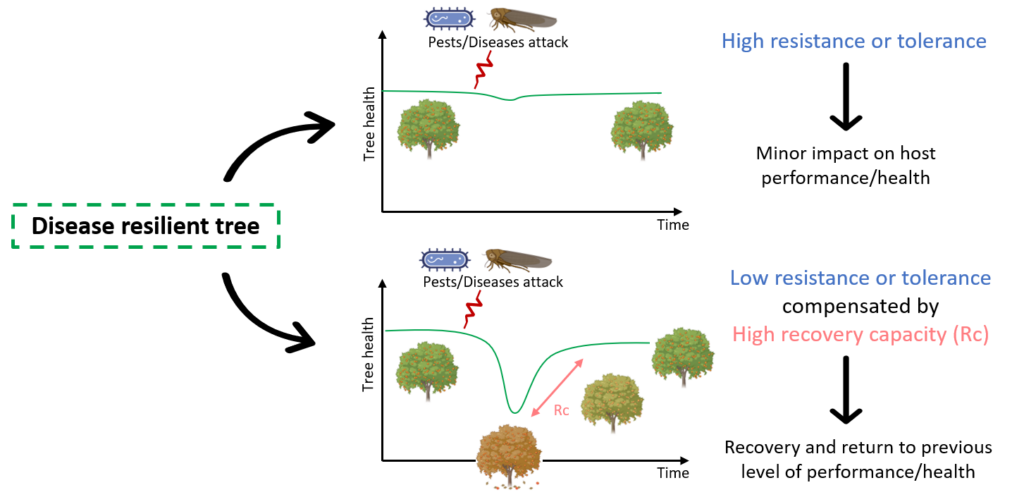[PhD defence] 29/11/2024 - Marie SERRIE: "Adapting Prunus to the reduction in the use of pesticides: identifying the components of resilience and exploiting diversity through association genetics" (UR GAFL)
Marie SERRIE will submit her thesis on 29 November 2024 on the theme: "Adapting Prunus to the reduction in the use of pesticides: identifying the components of resilience and exploiting diversity through association genetics"." .
Date and place
Oral defense scheduled on Friday 29 November 2024 at 9.00 am
Venue: Domaine St-Paul - Amphi Cœur de centre 228 route de l'Aérodrome, Site Agroparc, 84914 Avignon
Room: Amphi cœur de centre
Discipline
Biology
Laboratory
UR 1052 - GAFL - Genetics and Improvement of Fruit and Vegetables
Composition of the jury
| Ms BENEDICTE QUILOT | Avignon University and INRAE Centre PACA (UR GAFL) | Thesis supervisor |
| Ms Chloé DELMAS | INRAE Centre Bordeaux-Nouvelle Aquitaine (UMR SAVE) | Examiner |
| Ms Dominique THIS | The Agro Institute, Montpellier | Examiner |
| Guillaume CHARRIER | INRAE Centre Clermont-Auvergne-Rhône-Alpes (UMR PIAF) | Rapporteur |
| Charles-Eric DUREL | INRAE Centre Pays de la Loire (UMR IRHS) | Rapporteur |
| Ms Morgane ROTH | INRAE Centre PACA (UR GAFL) | Thesis co-supervisor |
| Mr Jean-Marc AUDERGON | INRAE Centre PACA (UR GAFL) | Thesis co-supervisor |
Summary
In a context marked by unpredictable epidemiological upheavals linked to climate change, fruit trees are faced with attacks from multiple bio-aggressors that are responsible for significant damage and threaten the sustainability of orchards. Selecting for multiple resistances through gene pyramiding is an effective strategy, but a particularly long and complex one. Alternative, more integrative selection targets now need to be considered in order to find sustainable alternatives to the systematic use of plant protection products in orchards. In this respect, resilience is an attractive concept that has yet to be fully explored in fruit trees. The main objective of this thesis is to acquire key knowledge on the resilience of fruit trees of the genus Prunus through the use of diversified plant material under conditions of low phytosanitary protection, and by developing appropriate methodological tools to characterise its components. Through a review of the literature, we began by demonstrating the value of resilience in fruit trees as a new, practical approach to breeding. We proposed a clear definition based on three components: resistance, tolerance and recovery. By regularly monitoring the symptoms of 10 pests in two core collections of peach (P. persica) and apricot (P. armeniaca) maintained under reduced phytosanitary conditions in five locations with contrasting environmental conditions, we quantified the cumulative susceptibility of the trees to the multiple pests that attack orchards, as well as their evolution over the years. We also characterised the behaviour of the trees in the face of these multiple stresses by phenotyping 'resilience biomarkers', i.e. variables reflecting the impact of the various pests on the health and performance of the trees, such as trunk growth, flower density and fruit load. Various genetic association models (GWAS) were tested to dissect the genetic architecture of resilience components. As a first approach, considering the pests individually made it possible to: i) classify them into different typologies according to the influence of the environment and G×E interactions, and ii) identify candidate QTLs, the majority of which are environment-specific or interactive (i.e. with effects modulated by the environment).
Our results indicate an over-representation of genes from the LRR-CRs family and a predominant role for basal and host-specific resistance mechanisms in the response to biotic stresses in these two species. As a second approach, multi-trait integrative methodologies were used to highlight the co-location of QTLs controlling different bio-aggressors. To further our understanding of resilience mechanisms, we monitored the growth of 10 peach accessions by measuring shoot length and twig diameter throughout the season. We thus determined which pests had the most pronounced impact on shoot growth and identified promising resilience indicators based on deviations between observed and expected performance. Finally, we constructed several indexes to identify resilient accessions within the core collections studied, enabling us to provide food for thought on the construction of resilient ideotypes. This work represents a promising first step towards identifying the components of resilience and understanding resilient behaviour in stone fruit trees. It will help to bring about a far-reaching and necessary change in the objectives of plant breeding in order to move towards resilient agricultural systems.

Keywords Prunus, Resilience, Pests and diseases, Association genetics (GWAS), Reduction of phytosanitary inputs, Multi-environment experimental networks
Updated on 19 November 2024